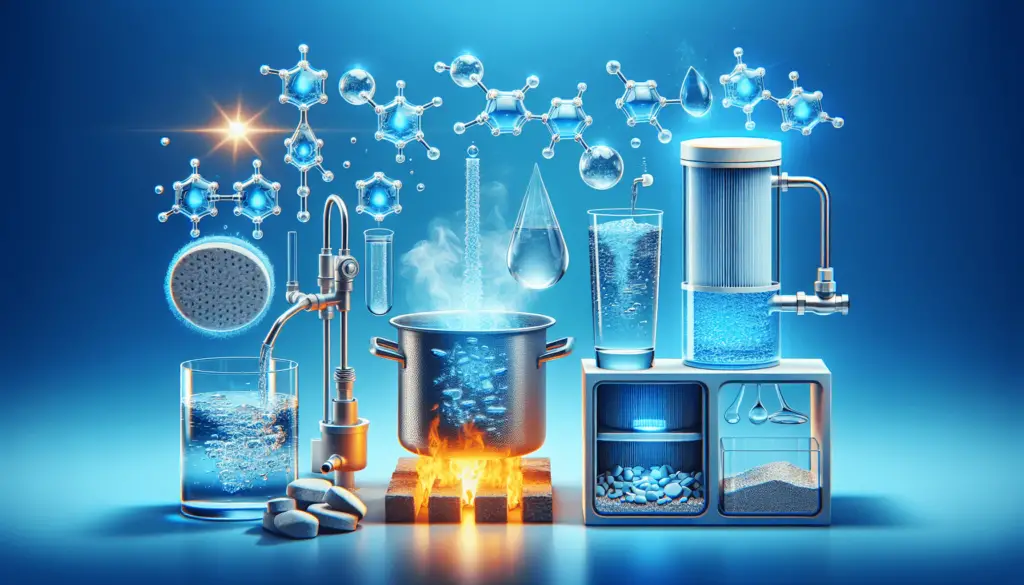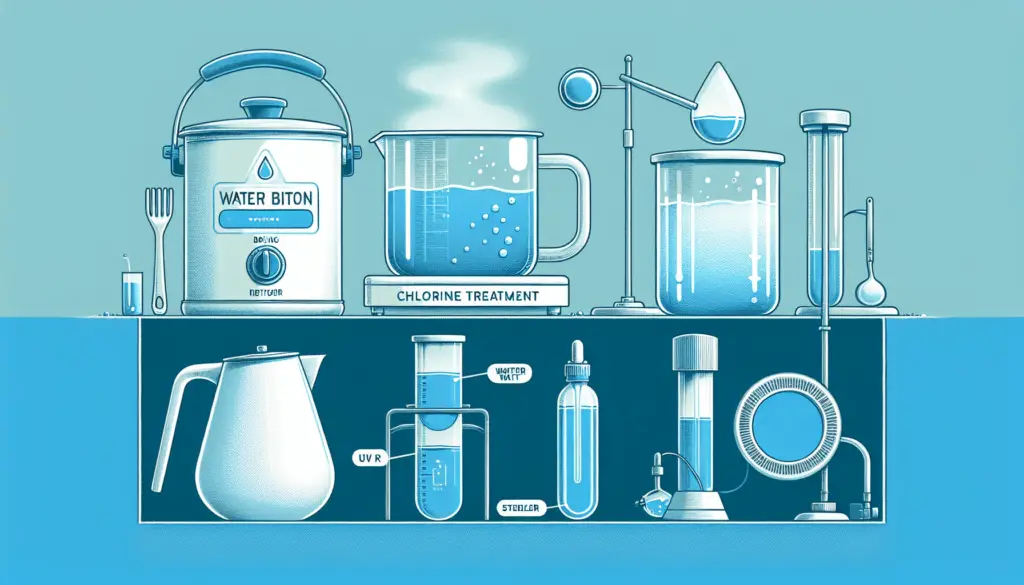Water is essential for our survival, and ensuring its purity is paramount. In this article, we will explore the pros and cons of various water purification methods. By examining the strengths and weaknesses of each technique, you will gain a comprehensive understanding of how these methods affect water quality. So, whether you are a concerned homeowner looking for the best water purification system or simply curious about the different approaches, this article will provide valuable insights to help you make informed decisions about your water source.
Boiling
Pros:
Boiling water is a simple, accessible, and inexpensive method of purifying water. By bringing water to a rolling boil, you can effectively kill most types of microorganisms, including bacteria and viruses. Boiling does not require any additional equipment or chemicals, making it a convenient solution in emergency situations or when access to other purification methods is limited. It is also worth noting that boiling can be done without electricity, making it a reliable option in areas with unreliable power sources.
Cons:
One of the main drawbacks of boiling water for purification is that it can be time-consuming. It takes time for the water to reach a rolling boil, and then you typically need to let it boil for at least one minute (or longer at higher altitudes) to ensure proper disinfection. Additionally, boiling does not remove chemicals or heavy metals from the water, so if you are concerned about these contaminants, you may need to consider other purification methods. Lastly, boiling may alter the taste and smell of the water, which can be a downside for some people.
Chemical disinfection
Pros:
Chemical disinfection is another effective method of purifying water. It involves the use of chemicals such as chlorine, iodine, or chlorine dioxide to kill microorganisms, including bacteria and viruses. Chemical disinfection is portable and easy to use, making it a convenient option for outdoor activities or emergency situations. It is also worth noting that chemical disinfection can effectively kill even hardy parasites like Giardia and Cryptosporidium, which can cause severe gastrointestinal illnesses.
Cons:
While chemical disinfection is effective at killing microorganisms, it does not remove chemicals or heavy metals from the water. This means that if you are concerned about these contaminants, you would need to consider other purification methods. Additionally, certain individuals may have allergic reactions to the chemicals used for disinfection, so it is important to be aware of any potential sensitivities before using this method. Lastly, chemical disinfection may leave an unpleasant taste and smell in the water, which can be a downside for some people.

Filtration
Pros:
Filtration is a commonly used water purification method that removes particles, sediment, and some bacteria from the water. Depending on the type of filter used, filtration can also improve the taste and smell of the water. There are various types of filters available on the market, including carbon filters, ceramic filters, and hollow fiber membranes, which cater to different needs and budgets. Filtration is also suitable for purifying large volumes of water, making it a practical option for households or groups.
Cons:
One of the drawbacks of filtration is that it may not effectively remove all types of microorganisms from the water. Some filters are better at capturing bacteria and larger particles, while others may be less effective against viruses or very small microorganisms. It is important to choose a filter that is specifically designed to target the contaminants you are concerned about. Another consideration is that filtration requires regular maintenance and replacement of filters to ensure optimal performance. This can incur ongoing expenses and may add to the initial cost of the filtration system.
Ultraviolet (UV) disinfection
Pros:
Ultraviolet (UV) disinfection is a non-chemical method of purifying water that utilizes ultraviolet light to kill microorganisms, including bacteria and viruses. It is a highly effective method that does not alter the taste or smell of the water. UV disinfection does not require the addition of any chemicals, making it a safe and environmentally friendly option. It is suitable for continuous use and does not leave any residue in the water.
Cons:
One of the main drawbacks of UV disinfection is that it requires a source of electricity to operate. This may be a limitation in areas with unreliable power sources or during emergencies. Another consideration is that UV disinfection is unable to remove chemicals or heavy metals from the water, so if these contaminants are a concern, you would need to explore other purification methods. Lastly, UV treatment may not be as effective on turbid or cloudy water, as the particles in the water can shield microorganisms from the UV light.

Reverse osmosis
Pros:
Reverse osmosis is a water purification method that removes a wide range of contaminants, including chemicals, heavy metals, and microorganisms. It is considered one of the most effective methods for providing high-quality drinking water. Reverse osmosis systems are suitable for various water sources, including tap water and well water. Additionally, reverse osmosis can be combined with other purification methods, such as carbon filtration, to enhance the overall performance of the system.
Cons:
One of the drawbacks of reverse osmosis is its high initial cost. Compared to other purification methods, reverse osmosis systems can be more expensive to install and maintain. Another consideration is that reverse osmosis systems waste significant amounts of water during the purification process. This is because the system relies on creating pressure to force water through a semipermeable membrane, resulting in a reject stream of concentrated contaminants. Regular maintenance and replacement of filters are also necessary to ensure the system operates effectively. Lastly, reverse osmosis has a slower filtration rate compared to other methods, which means it may not be the most practical option for high-volume water needs.
Distillation
Pros:
Distillation is a purification method that removes most contaminants, including bacteria, viruses, chemicals, and heavy metals, from water. It is a reliable method for producing high-quality drinking water. Distillation is suitable for various water sources, including tap water, well water, and even seawater. Additionally, it can be combined with other purification methods, such as activated carbon adsorption, to enhance its performance.
Cons:
One of the drawbacks of distillation is its high initial cost. The equipment required for distillation can be expensive, especially for larger-scale systems. Additionally, distillation requires a source of electricity to heat the water and facilitate the evaporation and condensation process. The purification process can also be slow compared to other methods, which may not be ideal for situations where immediate access to clean water is needed. Another consideration is that distillation may alter the taste of the water due to the removal of minerals. Lastly, the collection and storage of distilled water can be cumbersome and require proper hygiene practices to maintain its purity.
Activated carbon adsorption
Pros:
Activated carbon adsorption is a water purification method that mainly focuses on removing chlorine, taste, and odor from water. It is effective at improving the taste and smell of the water, making it more appealing to drink. Activated carbon filters can also remove some chemicals and heavy metals, providing an additional level of purification. This method is easy to install and use, often requiring minimal setup or maintenance.
Cons:
While activated carbon adsorption is effective at removing chlorine, taste, and odor from water, it may not effectively remove microorganisms. This means that if you are primarily concerned about microbial contaminants, other purification methods may be more suitable. Additionally, activated carbon filters have a limited lifespan and effectiveness for certain contaminants. Regular replacement of carbon filters is necessary to ensure optimal performance. It is also important to note that activated carbon adsorption may not be able to provide comprehensive purification for all types of water sources and contaminants.
Electrostatic precipitators
Pros:
Electrostatic precipitators are a water purification method that removes particles, sediment, and some microorganisms from water. They are particularly effective at purifying large volumes of water, making them suitable for industrial or municipal applications. Electrostatic precipitators have low energy consumption and require minimal maintenance, making them a cost-effective option in the long run.
Cons:
One of the limitations of electrostatic precipitators is that they may not effectively remove all types of microorganisms. While they can remove larger particles, smaller microorganisms may still remain in the water after purification. Electrostatic precipitators are also not suitable for removing chemicals and heavy metals from the water, so if these contaminants are a concern, alternative purification methods should be considered. Additionally, the effectiveness of electrostatic precipitators may be reduced in cloudy or turbid water, as the suspended particles can interfere with the purification process.
Activated alumina
Pros:
Activated alumina is a water treatment method mainly used for removing fluoride, arsenic, and selenium from water. It is effective at reducing the levels of these contaminants, making the water safer to consume. Activated alumina can be used as a standalone treatment method or in combination with other purification processes, providing flexibility based on specific needs.
Cons:
While activated alumina is highly effective for removing fluoride, arsenic, and selenium from water, its effectiveness for other contaminants may be limited. If you are concerned about different types of contaminants, it may be necessary to explore other purification methods. Regular replacement of alumina filters is also necessary to maintain the optimum performance. In certain regions, activated alumina filters may not be readily accessible or affordable, which can be a downside for those seeking this specific treatment method.
Ion exchange
Pros:
Ion exchange is a water purification method that focuses on removing calcium, magnesium, and other minerals from water. It is effective at improving the taste and purity of the water, particularly in areas with hard water. Ion exchange systems can be used as a standalone method or in combination with other purification methods, allowing for customization based on specific needs.
Cons:
One of the limitations of ion exchange is that it does not remove microorganisms from the water. If you are primarily concerned about microbial contaminants, other purification methods should be considered. Another consideration is that ion exchange systems require regular replacement or regeneration of resin filters to maintain their effectiveness. Depending on the region, these filters may not be readily accessible or affordable, limiting the feasibility of this method for some individuals.
